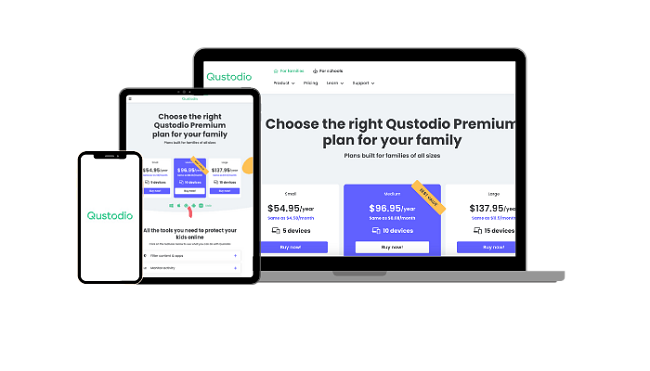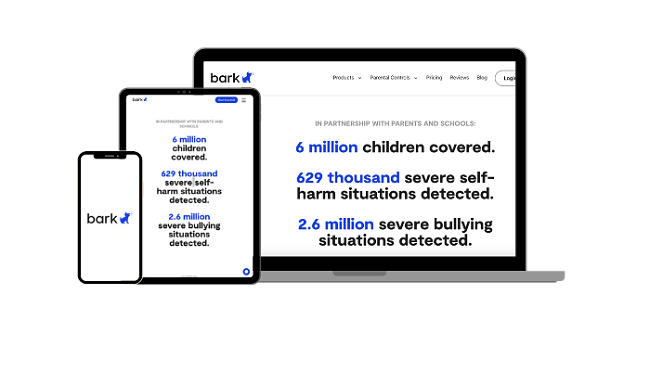Internet Safety For Teens: Everything Parents Need to Know in 2024
Parents of teens have a lot to worry about, from how much time their teen spends online, to the impact on their health and personality, and the types of websites and apps they access daily.
Managing and monitoring a teenager can lead to an endless cycle of arguments. They seek their freedom, while you, being responsible, aim to protect. I searched for a balance, allowing my teens to use the internet for educational and entertainment purposes but with limits.
Of the various solutions, the most effective was a parental control app. This non-invasive tool lets me set rules, monitor their activity, and view their location, without constantly intruding. After testing over 30 apps, Qustodio stood out as the best parental control app. It boasts a comprehensive web filter, customizable screen time limits, live tracking, and detailed reports. You can even try it free for 30 days, without needing a credit card, to determine its fit for your family.
Try Qustodio Free for 30 Days!
Quick Guide: How to Ensure Internet Safety for Teens in 2024
- Install a parental control app: Get a parental control app that can connect to multiple devices, so you can monitor their computer, laptop, phone, and tablet. I found Qustodio to be the best app for that, with powerful features that kids can’t easily bypass. You can try Qustodio for free for 30 days.
- Set custom rules: Using the parental dashboard, you can set screen time rules, enable the web filter and block apps and websites you don’t want your child using.
- Ensure your teens are safe online: Parental control apps allowing you to monitor what your kids are doing online and enforcing web filters and screen time limits. They are also capable of blocking inappropriate apps and URLs that are not safe for kids.
Best Practices to Improve Internet Safety for Teens in 2024
Understanding that there are safety concerns is just the first step. As parents, you need to have a strategy for giving your teen the freedom to be online, but in a safe manner. I’ve tried and tested many different methods to enhance online security. Here are the methods that worked best for me:
1. Comprehensive Monitoring of All Online Activity with a Parental Control App
Parental control apps have revolutionized how we ensure the safety of our teens in the digital age. These apps operate discreetly in the background, providing a sense of independence for teens while eliminating the feeling of being constantly watched. Simultaneously, they grant parents remote control, enabling them to manage the content their teens access, dictate online schedules, and receive timely updates on search queries. This blend of autonomy for the teens and peace of mind for me makes the parental control apps my top choice for keeping them safe online.
After testing more than 30 parental control apps, I found three that stood out above the rest in ensuring the online safety of my teens: Qustodio, Bark, and mSpy.
✅ Qustodio: Set Comprehensive Rules and Powerful Monitoring Tools That Are Difficult for Teens to Bypass
- Comprehensive web filter with 29 categories
- Set screen time limits for general use and specific apps
- Detailed activity reports
- Try it free for 30 days – No credit card needed!
Qustodio is the best parental control app I tested. It offers great internet safety tools such as a web filter, comprehensive screen time limits, and app blockers designed to keep my teens safe online.
The web filter has 29 categories to block content related to porn, gambling, violence, drugs, alcohol, weapons, and violence. These categories are turned on by default, while others like chats, social networks, news, and forums are set to allow the child to visit the site. Each category can be set to Allow, Block, or Alert Me. The Alert Me option won’t block your child from visiting the site, but will add an alert on the dashboard.
The filter also allows me to manually add websites that wouldn’t otherwise be blocked. This is particularly useful because while I don’t want to block all online gaming, there are certain violent games I’d prefer my teens avoid. The filter includes three settings that help keep my teens from bypassing it:
- Automatically block any browser that isn’t compatible with Qustodio.
- Block any website that Qustodio can’t categorize. Often, these are sites with vague metadata, limited text-based content, or those that prevent filters from accessing the content.
- Enforce SafeSearch on all major search engines.
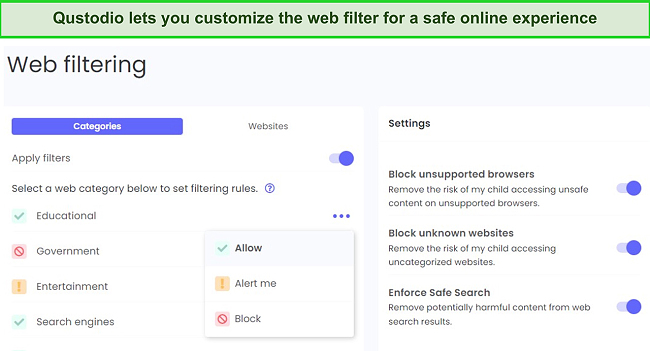
Qustodio’s screen time limiting features allow me to control when my teens’ devices can be used, set daily screen time limits, and apply individual limits for specific apps. There’s also an Instant Lock feature that lets me block their phone or computer instantly.
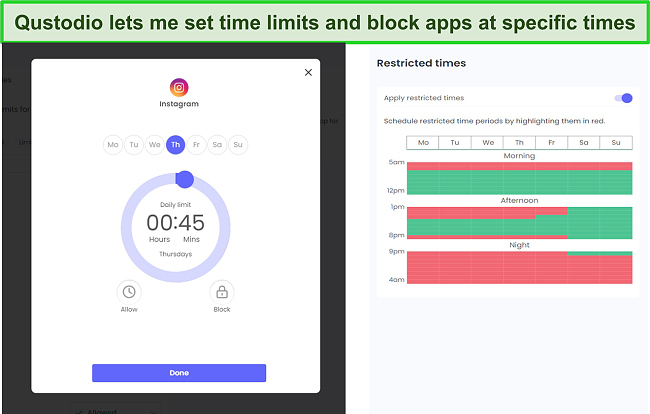
All of my kids’ online activities are uploaded to the Qustodio parental dashboard. This provides insight into what they’re doing online, how long they use each app, their browsing and search history, and their location. The data is saved for 30 days and displayed chronologically, making it invaluable for ensuring my kids’ safety and understanding their online behavior. If there are any concerning habits or actions, I can easily spot them.
Qustodio offers a 30-day free trial, with no credit card required. This is something I haven’t found in other parental control apps. You can try it out by installing it on your teens’ phones and computers, and then experience its powerful features for yourself.
✅ Bark: Monitors Your Teens Social Media Interactions to Keep Them Safe Online
- Use AI and machine learning to monitor social media, email, and browser use
- Customizable schedule lets you manage when your teen can access specific apps
- Try it free for 7 days!
Bark specializes in keeping teens safe on the internet, with an extra focus on social media. This app works with over 30 social media networks, messaging apps, email platforms, and web browsers. When setting up, you’ll need to provide Bark access to your child’s accounts. After this, it starts checking DMs, photos, comments, and videos for things like cyberbullying, mentions of drugs and alcohol, violent content, indications of self-harm, and more.
If the monitor detects potentially dangerous interactions, it copies the offending content and uploads it to the parental dashboard, along with category tags about why it was flagged, and expert advice for parents on how to handle the specific issue.
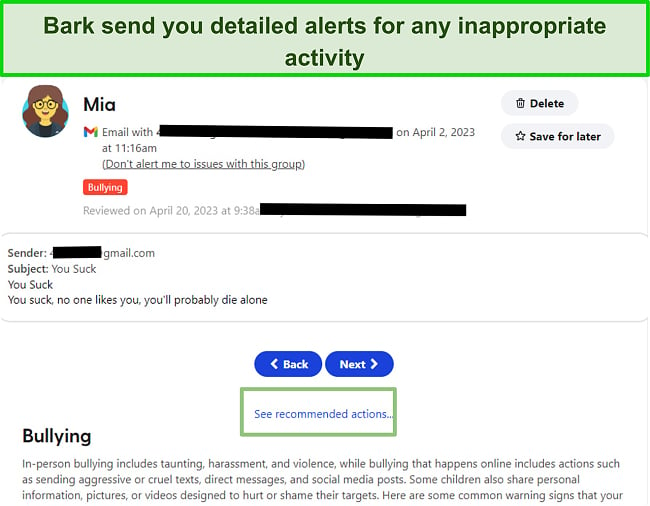
While Bark doesn’t have a traditional screen time limit tool, it lets me segment the day into different categories. I can then choose what apps and websites are available to my teens during each time segment. For example, during school time, I can block all social media and streaming apps and websites, but enable them during free time.
Its web filter, boasting 19 categories, is also managed through this segmented routine. Some categories are consistently off-limits for my teens. However, for others like sports and entertainment, I decide when they can be accessed and when they should be restricted, ensuring focused time for studies or other activities. The combination of the web filter and app management proved valuable in establishing a secure online space for my teenagers.
You can try Bark free for 7 days with their trial option, which is enough time to get an idea of how your kids act online, and whether there are any safety concerns that you should be aware of.
✅ mSpy: Integrated Screen Recorder and Keylogger That Tracks Everything Your Teen Does Online
- Sends alerts when your teens type potentially dangerous keywords
- Blocks apps and websites from opening
- Save 30% on all subscription plans
mSpy takes screenshots of your teen’s online activity, both at timed intervals and every time they open a new website or app. This is very useful because I can see everything that my teens are doing on their phone. The screenshots are uploaded to the parental dashboard, along with a timestamp and the app they were using at the time. It helps me keep them safe because I can see if they’re looking at potentially dangerous websites or being threatened or scammed online.
It also includes a keylogger, which records everything your teen types on their phone – even if they delete it without sending. This log, complete with a timestamp and the app the teen was using, gets uploaded. While it might seem overwhelming to sift through all your child’s texts, comments, and posts, mSpy simplifies things with its keyword tracker. I could input a list of specific words and phrases, and whenever my teen typed one of them, I received an alert. This allowed me to focus on the more critical logs rather than getting lost in the everyday chatter.
With mSpy, I can monitor SMS chats and 11 of the most popular messaging apps, including WhatsApp, Facebook Messenger, Telegram, Instagram, and Snapchat. Unlike the keylogger, the social media monitoring displays incoming messages too. This offers a complete picture of the conversation, letting me discern if my teen is joking or genuinely in a tight spot. Knowing the context helps in taking the right action to ensure their safety.
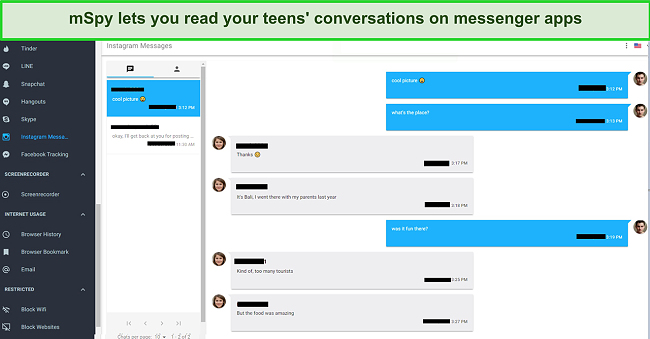
While mSpy doesn’t offer a free trial, there’s a Demo Mode on its website. This lets you preview the types of data it gathers and showcases its organized, user-friendly dashboard. Currently, mSpy is giving a 30% discount on all its plans – a great deal for parents looking to safeguard their teens online.
2. Open Communication with Your Teens
Maintaining open communication is essential for guiding your teens’ online behavior. Engage in conversations about their internet activities to foster trust and understanding. Sharing personal anecdotes and discussing potential online hazards can empower them to navigate the digital landscape cautiously. This proactive approach strengthens your relationship and helps them feel comfortable discussing any online concerns they may encounter.
3. Education and Awareness
Empower your teens with knowledge to navigate the online world safely. Educate them about identifying online scams, recognizing predatory behaviors, and discerning misinformation. Providing access to resources that promote digital literacy equips them with the skills needed to make informed decisions online. Staying informed together helps address emerging digital threats and challenges as a united front, fostering a safer online experience for the entire family.
4. Setting Boundaries and Limitations
Establishing clear boundaries is crucial in the digital age. Set reasonable screen time limits, discuss age-appropriate websites, and platforms. Emphasize offline activities to strike a balance between online engagement and real-world experiences. Encourage them to explore hobbies, sports, and socializing without screens, promoting a well-rounded lifestyle. This balanced approach ensures the holistic development of your teens in today’s interconnected world.
All of these methods are important when it comes to keeping your teens safe online. You must have an open line of communication, so they feel safe coming to you in case of danger or something they’re unsure about. Similarly, educating them about the dangers and setting boundaries are important conversations to have with your teens.
However, parent’s simply can’t always be there to look over their teens’ shoulders, and some teens think they’re smarter than their parents and don’t want to involve them. That’s why it is essential to install a parental control app on their devices. It has the tools needed to keep your teen safe, such as web filters, app blockers, and screen time limit tools.
FAQ
Why is monitoring a teenager’s internet use important?
How can I educate my teen about online scams and predatory behaviors?
What are parental control apps and how can they help create a safer online environment for teens?
Parental Control App is an Essential Internet Safety Tool for Teens
Keeping your teens safe on the internet demands a fine balance: We must protect them from potential threats, yet also empower them with the freedom to navigate, explore, and learn. It’s crucial that you stay engaged, informed, and proactive, ensuring your teens’ online experiences are both enriching and secure. By actively participating in their online activities and monitoring their interactions, you can foster a safe and positive environment that prepares them for the risks and dangers they may face.
After testing many different strategies, parental control apps proved to be the most comprehensive, and easiest, solution for keeping my teens safe on the internet. They seamlessly integrate protection with independence, allowing me a watchful eye without being overly intrusive.
Of the more than 30 apps that I tested, Qustodio stands out as the best option. It has powerful features, including web filters, screen time limits, live tracking, and detailed reporting. Best of all, you can try Qustodio free for 30 days, no credit card required, so you can test it for yourself and see if it‘s a good fit for your family.

